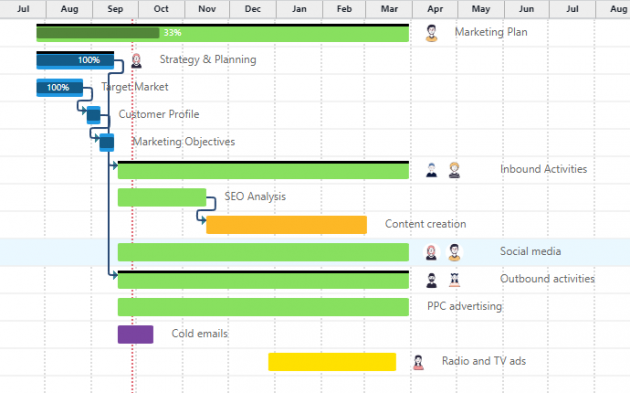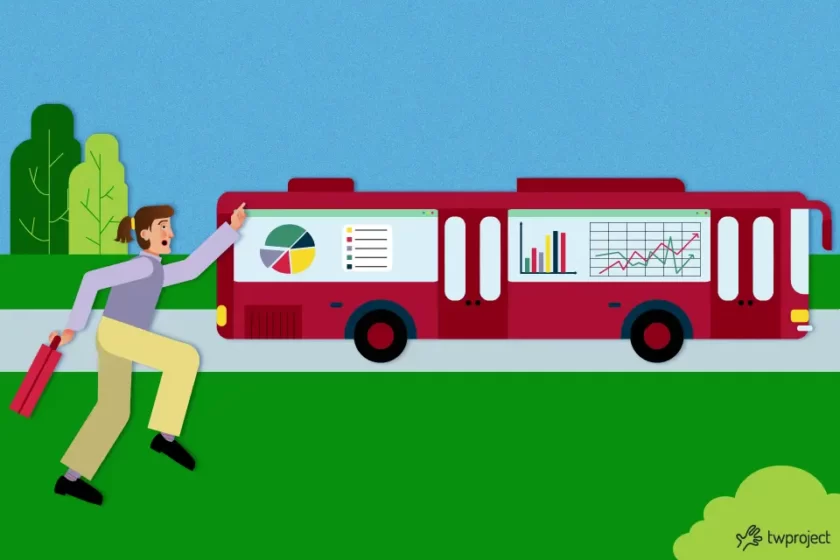Managing a delayed project start is a great challenge for a project manager, who must catch up without compromising the quality and goals of the project.
Although it may seem daunting, with the appropriate project management methodology and effective tools such as Twproject, it is possible to get the entire workflow back on track and ensure success.
Let’s look below at what to do in such cases.
CONTENT
- How to manage a late-starting project?
- 1. Analyze the causes of the delay
- 2. Redefine objectives and priorities
- 3. Optimize planning with visual tools
- 4. Improve internal communication
- 5. Adapt your methodology and workflow
- 6. Constantly monitor and learn from the process
- How to recalibrate time and resources?
How to manage a late-starting project?
1. Analyze the causes of the delay
The first step is understanding what went well and what caused the delay. It could be an underestimated planning phase, a lack of resources, or poor communication between team members.
With Twproject, analyzing delays becomes more straightforward and more objective. This software keeps track of every activity, actual times, workloads, and team interactions. Using customizable reports, you can view in just a few clicks:
- Differences between project planning and execution;
- Areas where the estimated schedule does not reflect the actual one;
- The bottlenecks that slow down the project life cycle.
Moreover, thanks to Twproject‘s interactive dashboards, you can compare each stage of your project and quickly determine whether delays are due to poor planning or operational inefficiencies.
2. Redefine objectives and priorities
When you have tracked down the causes, you can define the scope of your project more realistically. It is key to make clear which results need to be achieved and which ones can be pushed back or scaled down.
In Twproject, you can update your project goals, change deadlines and assignments, and notify each team member of changes in real time. This reduces friction and keeps everyone on the same page.
3. Optimize planning with visual tools
Effective planning is key to saving time. Gantt charts are excellent for visualizing each phase and understanding where to take action to speed things up.
With Twproject, you can manage Gantt charts dynamically: move tasks, reassign resources, and update dependencies between operations directly from your timeline. This helps you keep a grip on things during project execution and adapt quickly to changes.
4. Improve internal communication
Poor communication often amplifies delays. Every team member needs to know what to do, when, and with what resources.
Twproject centralizes information, allowing comments, attachments, and discussions on each activity, reducing data loss between emails and meetings.
Clear communication is essential to project management and can prevent further delays.
5. Adapt your methodology and workflow
All projects have their own lifecycle and, consequently, a more delicate project phase. Choosing the most suitable project management methodology, whether Agile, Waterfall, or Hybrid, can make the difference.
Your choice of methodology must be consistent with the complexity and flexibility required. With Twproject, you can manage both agile and traditional projects simultaneously, customizing the workflow to suit each phase of your project.
6. Constantly monitor and learn from the process
Throughout project execution, constantly monitor time, costs, and resources. Twproject offers dashboards and reports that help you understand whether you are heading in the right direction and how far you are from achieving your goals.
In the end, it will analyze what went well and what could be improved. This reflective approach strengthens the team’s skills and makes project management increasingly efficient.
How to recalibrate time and resources?
Understanding how to manage a project lagging behind schedule also means strategically recalibrating time and resources without sacrificing quality or team motivation. When the schedule falls apart, the priority is to realign your workflow and redefine your operational priorities.
A skillful project manager understands that not everything can be recovered in the same way: some operations can be cut short or delegated. In contrast, others must be kept intact to ensure consistency with the project objectives.
Analyze the current situation
First, check the length and magnitude of each activity. Use Gantt charts to visualize the relationships between tasks and understand which critical tasks dictate the project’s overall duration. With Twproject, you can do this in just a few clicks, modifying deadlines, dependencies, and workloads directly in the timeline.

Reorganize resources and priorities
In the updated planning phase, you may decide to:
- Shift resources from secondary activities to priority ones;
- Add parallel tasks to accelerate the project phase;
- Add more frequent checks to prevent further delays.
Twproject provides real-time insight into each member’s availability and allows you to reassign tasks in a balanced manner. This ensures that project execution remains smooth and under control, avoiding overload or downtime.
Another key aspect of project management is reducing wasted time in communication. With Twproject, you can set up automatic alerts when tasks change status or deadlines, so every team member is always up to date on overall progress.
Lastly, remember that recalibration isn’t a failure but a proof of expertise- it means knowing how to adapt the plan to achieve goals even in tough circumstances.
How can you prevent future delays?
An experienced project manager knows that true strength lies in recovering a delayed project and preventing it from occurring again. To do this, it is vital to examine what went well and what can be improved, documenting the lessons learned.
Once your project is over, conduct a review meeting with all team members. Analyze each phase of the project, from the planning phase to the execution phase, identifying errors, successes, and areas for improvement.
Twproject simplifies this process with final reports and activity logs that show actual times, variations, and performance for each resource.
This approach allows you to define the scope of your project more accurately in future efforts, preventing overly optimistic estimates and recurring problems.
Another way to prevent delays is to create standard templates for repetitive tasks. In Twproject, you can save model projects with pre-set tasks, resources, and deadlines, which can be tailored as needed. This reduces initial errors and speeds up the start-up phase, improving the entire project lifecycle.
Continuously monitor planning
Prevention also requires constant monitoring. Project management software such as Twproject allows you to track key performance indicators (KPIs), deadlines, and workloads. Automatic alerts flag delays early on, allowing you to intervene before they become critical.
Managing a delayed project requires focus, method, and the right tools. With excellent software, the right project management methodology, careful review of each phase, and the commitment of every team member, even a difficult start can turn into a successful outcome.





Thanks for the article. Managing delayed projects requires careful analysis and effective tools like Twproject to get things back on track without compromising quality or goals.